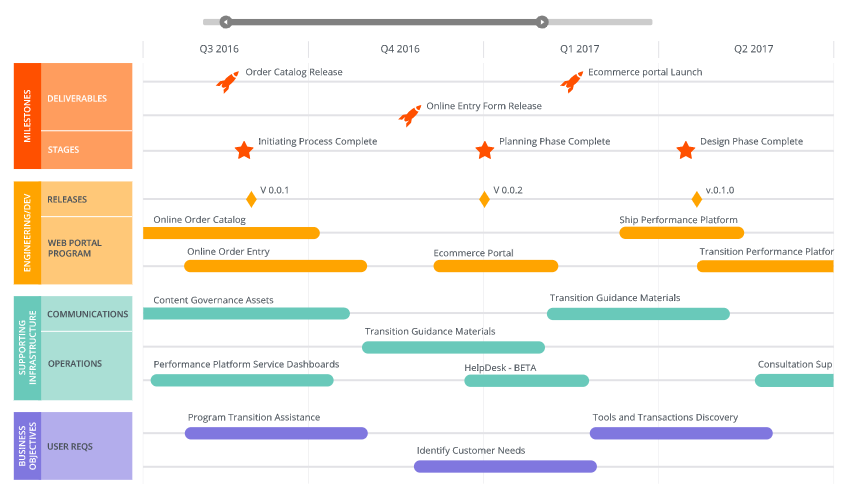What is a program of work
A program of work is composed by multiple linked projects and smaller activities that are delivering toward a shared business objective or vision, the objective is unique to the company or client.
What is the difference between project and program
Projects are specific in time and deliveries a Program deliver a predefined complex business objective or vision within a longer period or until the objective is delivered. Managing a program means managing changes throughout the duration of the program and affecting project within the program to achieve it.
How to set up a program of work
There are some steps you need to go through before having the program running.
- Identify the business objective that need to be delivered from the program. This could be a new product, a return of investment, or simply improving efficiency within the company in terms of resources and communication.
- Identify the projects that are going to be part of the program based on the defined business objective.
- Set up the project / program processes and way of working. This imply looking at tools and processes that can be used to help managing the project and the whole program. As each program has unique challenges the tools and processes need to be customised to the program.
Guideline to set up a program of work
To set up and manage a program you need to have an overall view of the program with enough details to be able to make decision and changes based on it. The essential steps to set up the program are the following:
- A program roadmap with the vision of the program in the future.
- A clear process in place to allow the team involved in the program/projects to work in a consistent manner using the MSP principles.
- Governance , to be able to manage a program effectively you need to have governance in place. This will define roles / responsibilities and processes for the program. have a top level vision of the program status and make decision together with the stakeholders. Program reporting tools,
The vision (roadmap)
A roadmap is a top level planned view of the activities / projects needed to achieve the program objective or vision. This top level view is taken at the moment you create it, without the full details of the projects or activity. Once the roadmap is set up it will be periodically reviewed and refined to achieve the program goals. You can create a roadmap with different tools / templates as long it is agreed and clear to the stakeholders. In principle a roadmap is similar to a project Gantt chart without the details.

The process
Once you understand your program goals you need to set up the process and ways of working that will help you to achieve them. This is also something that is very specific to companies and clients and need to be carefully planned. It can be a complete transformation of the ways of working or just some adjustment and small additions to what already exist to integrate the program within the current process. In both cases the principles of what your process need to cover are the same, and these are well defined in the Managing Successful Programmes (MSP®) framework 7 principles:
- Remaining aligned with business objective. Planning and refining the roadmap to achieve program goals and align to change in strategy.
- Leading changes to the program in order to achieve the goals. The program leader need to manage successfully changes in the program, from problem solving to changing team staff.
- Envisioning and communicating a better future. Share the vision, share the program vision with the team and communicate any change effectively.
- Focus on delivering the program benefits and manage any threats to deliver them.
- Adding value to the organisation, the program should always add value to the organisation to be successful.
- Designing and delivering a coherent capability that are in sync with the program goals and deliverable. A program should optimise operations and identify inter-project dependencies.
- Learning from experience, which tells us not to repeat the mistakes that might affect the success of the program. We should assess and learn from the team and improve / adjust the program accordingly.
The governance
In order to manage a program successfully you need to have control and visibility of it, governance is what give you the tools to successfully implement and manage the program within your organisation.
Firstly you need to identify the team and resources needed to deliver the program. Once agreed and defined each team member need to have a clear R&R definition to avoid confusion and have consistency in roles.
Once you have your teams roles identified you need to outline a clear consistent process and ways of working and communication between teams.
Now you need a reporting system that will allow you to control and manage the program. Usually you will need different reports for different stakeholders, operational stakeholder will need a detailed reporting while senior stakeholder need a more top level approach. You need to make sure you have the right balance of reporting and standardise the reporting for each level of stakeholder to have efficiency.
The number of reports in a program depending from the complexity can start with 3 level/type of reports to help managing the projects/program:
- Finance report project / program
- Status report – project/program
- Roadmap vision refinement
1. Financial report
It is important that you monitor the finance health of your project/ program. You will need to have a burn report with projections of burn for the project and program. This give a value to the project/program against the deliverable and help to make decision on what is financially viable or not. This report is usually an internal weekly report and it is project based and then aggregate to a program based report. it should contain:
- Burn up to the current week
- Projection of burn up to the end of the project/program
2. Status report
A status report on the project/program is usually a weekly report that will contain the status of the project / program. It helps to derive decisions, enabling the program manager and the stakeholders to make informed decisions. The main information it should contain are:
- Delivered item during the period (week)
- Planned deliverable for the next period(week)
- Burn up to date and projection to the end of the project/program
- Any escalation or delay that need stakeholder attention
- Risks and mitigation’s log for the project/program
- decision log
3. Roadmap vision refinement
Periodically the program director / manager and the stakeholder will review the original roadmap and vision and refine it or change according to changes in the organisation strategy or other factors affecting the original vision. Changes to the roadmap can affect projects teams and activities in the program. These changes are agreed at senior stakeholder and program direction level. They will be implemented by the program manager/director.
Available tools
To manage programs there are a variety of tools available online or as desktop programs. I mention some of the available tools below, but anybody can create their own template with a simple excel if they can’t access these.
- Financial report (burn report)
- Status report
- Roadmap
Conclusion
You need to evaluate the benefit of running a program instead of stand alone projects. It will depend on multiple factors: cost, resources, client needs, vision. Once the decision is made is very important that you get the stakeholder agree on the vision and the new way of working. Share with the team the vision and make them part of it. This article does not talk about any particular methodology needed for managing a program as it is agnostic and depend from the organisation choice of project management methodology. The benefits of running a program are multiple:
- Easy to share resources
Sharing resources between projects is managed and prioritised based on a common vision/program - Help to better manage conflicts
Conflicts and clashes between projects are identified earlier and managed. - Top level view
It give the stakeholders a comprehensive view of the project and help prioritising projects based on a agreed vision of the program - Consistency
Having a consistent process help standardise the way of working for all the projects. - Cost saving
Having a overall view and control of all projects help avoid duplication of work and efficiency.

I am a problem solver, a communicator and a digital entrepreneur. I have more than 20 years experience in digital and advertising, I went through all the digital revolution / evolution, starting my career as a developer and ending up on the dark side as a Manager.





